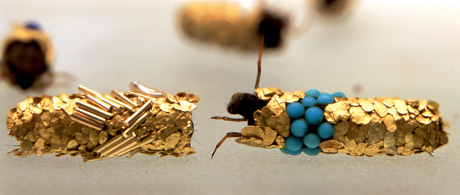Intelligent Design? How Smart are Bugs, Then?
... A small winged insect belonging to the order Trichoptera and closely related to the butterfly, caddis flies live near streams and ponds and produce aquatic larvae that protect their developing bodies by manufacturing sheaths, or cases, spun from silk and incorporating substances—grains of sand, particles of mineral or plant material, bits of fish bone or crustacean shell—readily available in their benthic ecosystem ...Here we have insects, which have no brain to speak of (unless one wishes to so stretch the definition of "brain" that it includes a few swellings along ganglia) creating objects that are very much in keeping with human aesthetics. If we did not know the origin of these objects, in fact, most people (myself included) would be very tempted to interpolate the involvement of intelligence, yet there is none involved in their manufacture.
Duprat, who was born in 1957, began working with caddis fly larvae in the early 1980s. An avid naturalist since childhood, he was aware of the caddis fly in its role as a favored bait for trout fishermen, but his idea for the project depicted here began, he has said, after observing prospectors panning for gold in the Ariège river in southwestern France. After collecting the larvae from their normal environments, he relocates them to his studio where he gently removes their own natural cases and then places them in aquaria that he fills with alternative materials from which they can begin to recreate their protective sheaths... (Source)
So much for Dembski's design inference filter.






